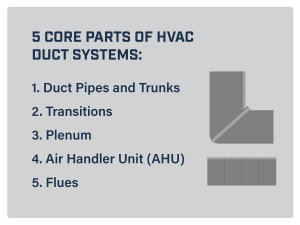What Are The Main Components of Residential Ductwork?
Homeowners rely on their residential HVAC system to keep their indoor air climate at the perfect temperature. However, many don’t know much about the role ductwork plays in maintaining a home’s air climate.
5 Core Parts of HVAC Duct Systems
There are several components crucial to your home’s ductwork. Knowing some of the inner workings of your air conditioning and heating system can be beneficial in troubleshooting duct problems and can help you communicate any issues to your maintenance professional. Here are the HVAC duct essentials and functions you should familiarize yourself with:
 1. Duct Pipes and Trunks
1. Duct Pipes and Trunks
Think of the pipes and trunks as the principal conduits for air to travel throughout your home. Duct trucks, which are usually made from steel, branch off directly from the furnace. Duct pipes extend from the duct trunks and connect to each room in your home. Duct pipes are often constructed from galvanized steel, but some are crafted from flexible aluminum, which allows them to bend and shape to a given space.
In addition to pipes and trunks, your intricate system also consists of other ducts designed to deliver air into areas of your residence. For example, stack boots and heads help facilitate vertical air movement, which allows for more effective air distribution.
2. Transitions
Duct transitions help connect or “transition” duct pipes and trunks. Transition pieces create pathways for air to travel effectively and efficiently throughout your ductwork. One of the main types of transitions is called a take-off, which transfers air from the duct trunk to individual pipes. Their design helps to maximize efficient airflow, which can save on energy costs. Other common types of transactions are turning vanes and cleats.
3. Plenum
Also known as an air distribution box, a plenum is one of the most essential elements of a residential HVAC system. Its main functions are to bring in and distribute air. There are two categories of plenums:
- Return plenum boxes: gather air from the return vents and deliver it to your heating and cooling unit to be cooled or heated again.
- Supply plenum boxes: connect to your AC, heat pump, or furnace, and push the newly conditioned air to the ducts.
4. Air Handler Unit (AHU)
The AHU is a large metal box, attached to the duct system, containing the blower fan, dampers, heating and cooling elements, and the air filter. The fan assists in distributing air through the ducts after the air has been brought to the proper temperature.
5. Flues
Similar to a chimney flue, HVAC flues are engineered to distribute air outside. Typically, flues are utilized when heating gas is used and harmful air or gasses such as exhaust or combustion byproducts need to be vented away from the home.
Do You Need to Replace or Repair Your Ducts?
As you can see, duct systems have a plethora of integral parts, so keeping them well maintained is crucial to their longevity. Well-cared-for systems can last anywhere from 10 to 15 years. If you have questions about your ducts or have concerns they might not be functioning properly, you should schedule a professional consultation with a reputable HVAC installer.
Residential HVAC Services
AAA Heating and Cooling is your residential ductwork professional serving both Beaverton and Portland. Our NATE-certified technicians can perform routine maintenance to keep your ducts in top shape. We also offer expert repair and replacement. Contact us today for all your ductwork and HVAC needs.